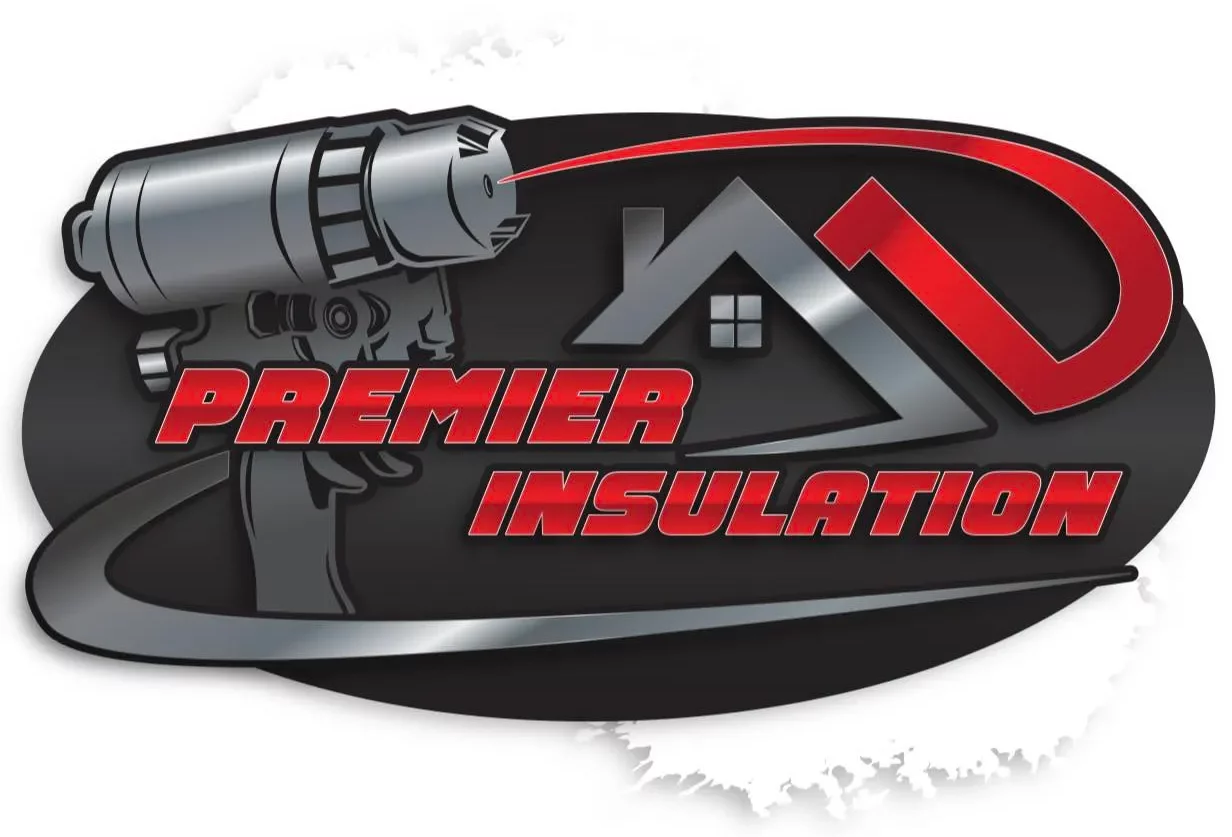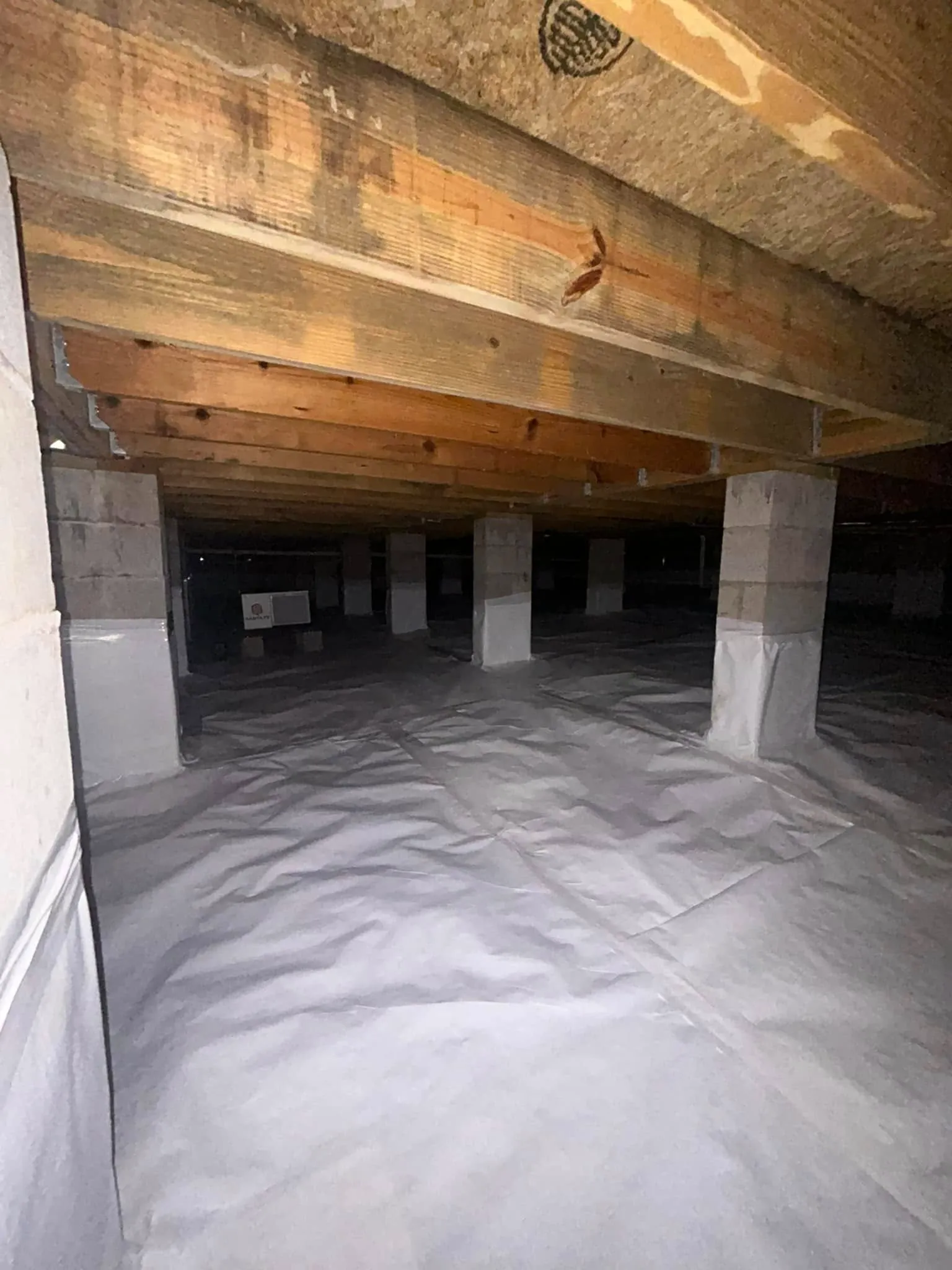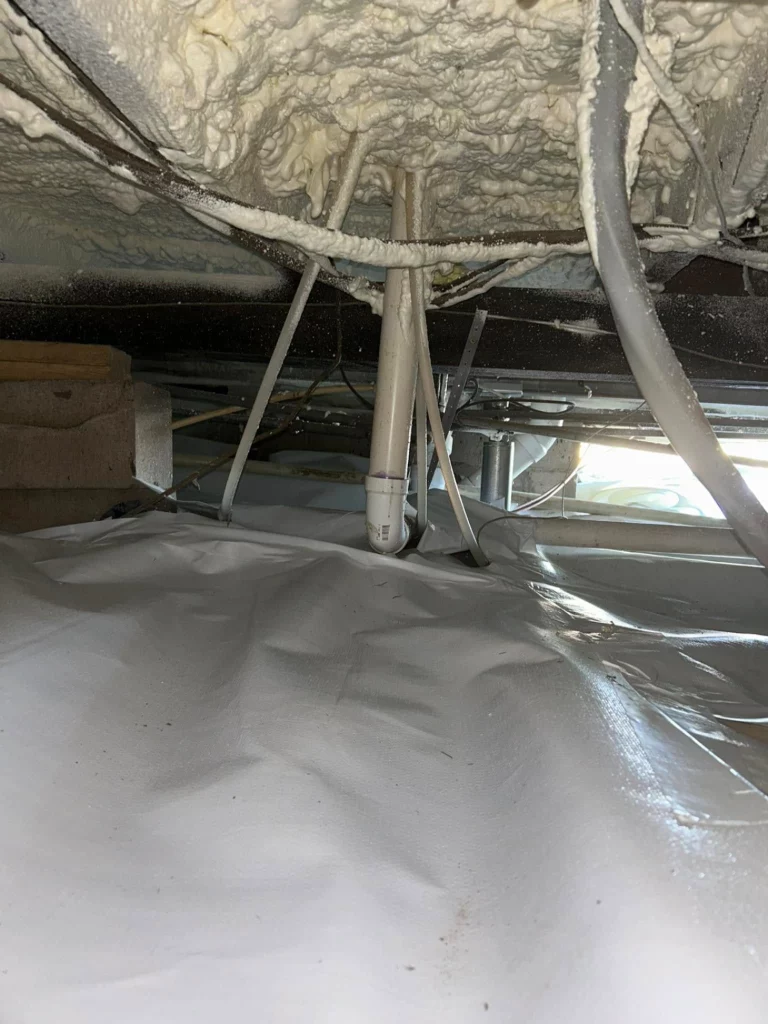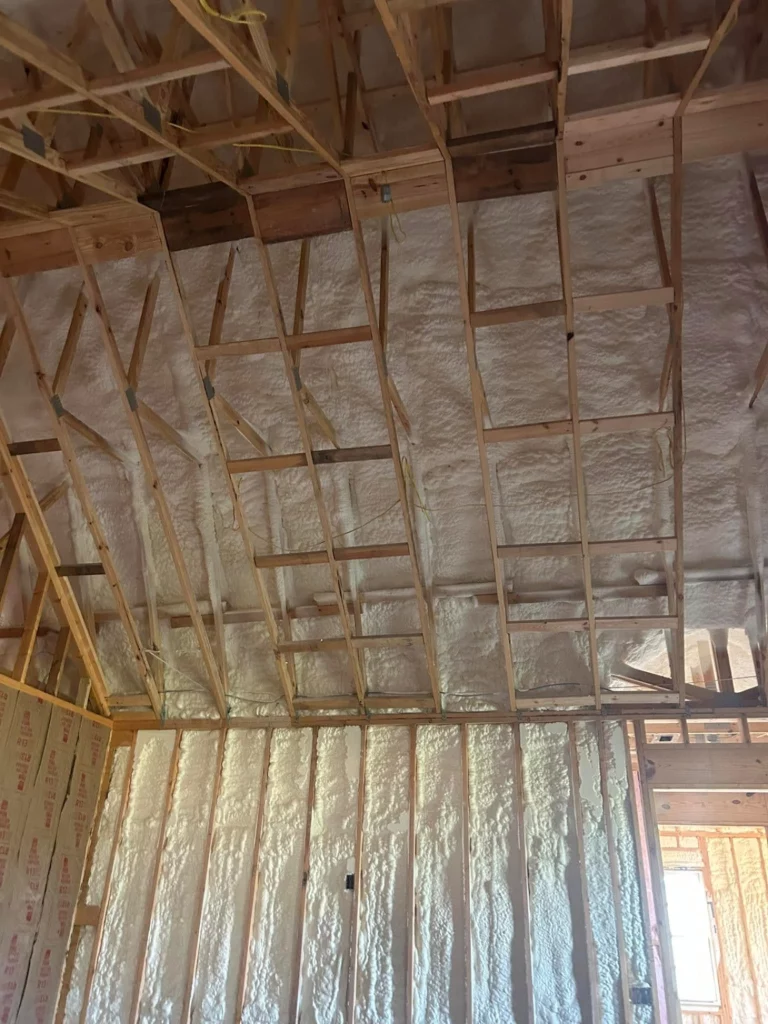Crawl space encapsulation improves your family’s comfort by regulating indoor temperatures, improving air quality, reducing humidity, deterring pests, eliminating musty odors, and creating a quieter home. By sealing the crawl space from the earth and outside air with a heavy-duty vapor barrier, insulation, and a dehumidifier, you create a clean, dry, and conditioned space beneath your home. This directly influences the living environment above, turning a problematic area into an asset that contributes to a healthier and more comfortable house.
This guide explains the specific ways sealing your crawl space makes a noticeable difference. With extensive experience in conditioning home envelopes, the team at Premier Insulation GA has seen firsthand how this process resolves common household issues that many people don’t realize originate from the ground up.
Stable Temperatures and Warmer Floors
One of the most immediate benefits of crawl space encapsulation is more consistent indoor temperatures. A traditional vented crawl space lets in cold air during the winter and hot, humid air in the summer. This unconditioned air makes the floors above it cold to the touch in colder months and can allow heat to radiate upwards in warmer months, forcing your HVAC system to work much harder.
By sealing the vents and insulating the foundation walls, encapsulation stops this exchange of air. The crawl space temperature stays much closer to the temperature of your home, which means your floors feel more comfortable year-round. This thermal consistency reduces drafts and cold spots in your living area, making the entire home feel more pleasant.
Better Indoor Air Quality
A significant portion of the air you breathe inside your home originates from the crawl space due to a phenomenon known as the “stack effect,” where air naturally rises. A report from the U.S. Department of Energy explains how air flows from lower to upper levels of a house. If your crawl space is damp, dirty, or filled with allergens like mold spores and dust mites, that’s the air circulating through your living room and bedrooms.
Encapsulation isolates your home from the damp earth and outside pollutants. In fact, the U.S. Environmental Protection Agency highlights that controlling moisture is the key to preventing mold growth indoors, a problem that frequently starts in unmanaged crawl spaces. Sealing the space with a vapor barrier and conditioning the air prevents mold, mildew, and other allergens from growing and entering your home’s air supply. This is particularly beneficial for family members with asthma or allergies.
Lower Humidity and Moisture Control
In humid climates like Georgia’s, vented crawl spaces are notorious for trapping moisture. This high humidity can lead to wood rot, damaged floor joists, and that persistent musty smell. Encapsulation is the most effective way to control moisture.
The process involves:
- Installing a thick, durable vapor barrier across the entire crawl space floor and up the walls.
- Sealing all vents and air leaks to the outside.
- Often, adding a dehumidifier to actively remove moisture from the air.
This system keeps the relative humidity in the crawl space at a safe level, protecting your home’s structural integrity and preventing the damp, sticky feeling that high humidity creates inside the house.
Bonus Tip: Before encapsulation, ensure any existing water intrusion issues, like poor grading or downspout problems, are fixed. The system is designed to keep moisture out, but it’s best to solve bulk water problems first.
A Less Inviting Home for Pests
Dark, damp, and cluttered crawl spaces are an ideal habitat for pests like termites, spiders, cockroaches, and rodents. These pests can easily find their way into your home through small gaps in the flooring and walls.
An encapsulated crawl space is dry, clean, and sealed. By removing the moisture and sealing entry points, you make the area completely inhospitable to pests. This clean environment is a powerful form of pest control that doesn’t rely on chemical treatments.
No More Musty Odors
That “old house smell” is often just the smell of a damp, moldy crawl space. Odors from mildew, decaying organic matter, and rodent droppings in the crawl space get pulled up into your living area. Air fresheners and candles can only mask the problem.
Encapsulation addresses the source of the odors by creating a dry and clean environment. Once the moisture and mold are gone, the musty smells disappear with them, leaving your home smelling fresh and clean.
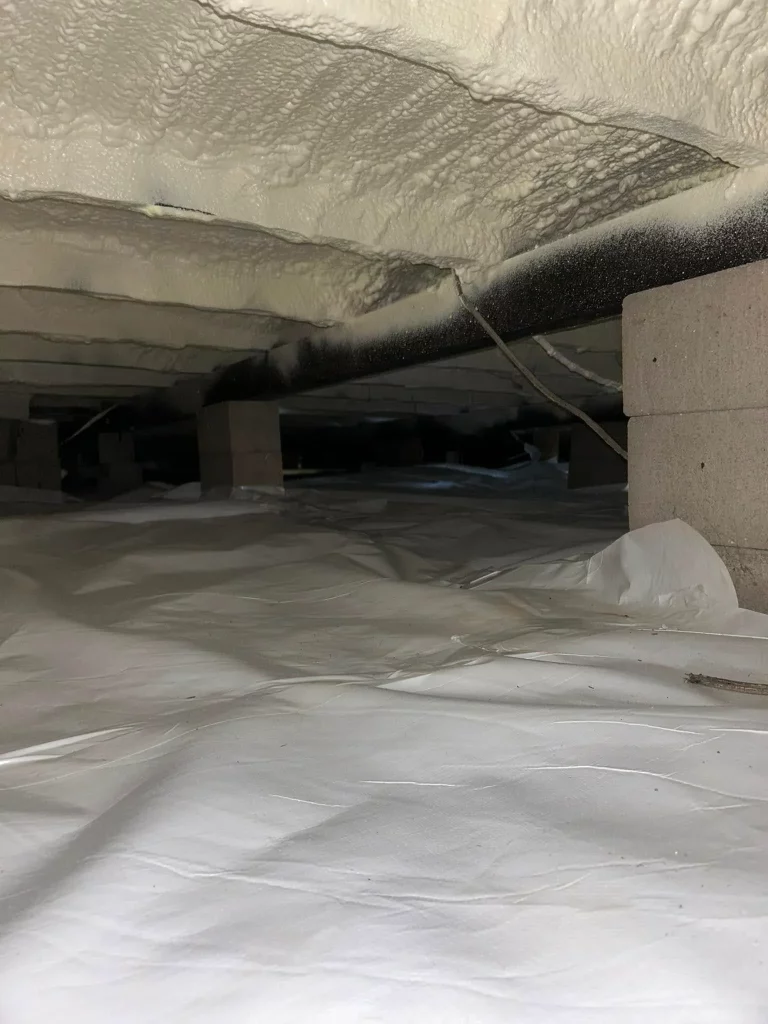
A Quieter Living Space
While not its main purpose, crawl space encapsulation can also contribute to a quieter home. Insulating the foundation walls and sealing air leaks can help dampen noises from outside. This is a secondary benefit, but reducing ambient noise can certainly add to your family’s overall comfort and peace.
Vented vs Encapsulated Crawl Space
The table below highlights the key differences between a traditional vented crawl space and a modern encapsulated one.
| Feature | Vented Crawl Space | Encapsulated Crawl Space |
|---|---|---|
| Temperature | Prone to extremes, causing cold floors | Stable, closer to home’s temperature |
| Humidity | High, especially in summer | Controlled and low (typically <55%) |
| Air Quality | Poor; allows mold, dust, and allergens | High; clean, filtered, and dry air |
| Pest Risk | High; attractive to pests and rodents | Low; sealed environment deters pests |
| Odor | Often musty and unpleasant | Neutral and clean |
Things to Consider Before Encapsulation
Before moving forward with a project, it’s important to assess a few key factors. First, evaluate the current state of your crawl space. Look for signs of standing water, active leaks, mold growth, or pest infestations. These issues need to be resolved before the encapsulation system is installed. Second, understand that a complete system includes the vapor barrier, sealed vents, wall insulation, and a dehumidifier. Skipping a component can compromise the results. A long-term study by Advanced Energy found that closed crawl spaces with dehumidification offered reliable moisture control and energy savings.
Finally, consider the climate. In the Southeast, with its high heat and humidity, encapsulation is an extremely effective strategy for improving home comfort and efficiency.
A More Comfortable Home from the Ground Up
Improving your family’s comfort isn’t just about what happens in the living room or kitchen. It’s about creating a healthy environment for the entire house, starting from the foundation. Crawl space encapsulation provides a lasting solution to problems like poor air quality, inconsistent temperatures, and moisture issues. By transforming the area beneath your home, you directly enhance the quality of the space you live in every day. Consider inspecting your crawl space to see if it might be the hidden source of comfort issues in your home.
Get a Professional Assessment
Every home is different, and a thorough inspection is the best way to understand your crawl space’s specific needs. A professional evaluation can identify moisture sources, check for structural issues, and determine the right course of action. For a detailed assessment, you can contact Premier Insulation GA at (229) 554-3939 to ensure your home is as comfortable and healthy as it can be.
Sources
- U.S. Department of Energy – This resource explains the principles of air movement in a home, including the stack effect.
- U.S. Environmental Protection Agency – This guide provides official information on why moisture control is essential for preventing indoor mold growth.
- Advanced Energy – This nonprofit organization provides research and field test data on the energy savings and moisture control benefits of closed crawl spaces.
Frequently Asked Questions About Crawl Space Encapsulation
Is a vapor barrier enough?
A simple vapor barrier on the floor is a good start, but it’s not encapsulation. A full encapsulation seals the walls and vents as well, creating a completely isolated space.
Will my energy bills go down?
Yes, many homeowners see a reduction in their heating and cooling costs. Because your HVAC system doesn’t have to fight against extreme temperatures coming from the crawl space, it runs more efficiently.
What kind of maintenance is required?
Maintenance is minimal. It typically involves checking the dehumidifier’s filter and having a professional inspect the system annually to ensure the liner and seals are intact.
How long does the encapsulation process take?
For an average-sized home, the process usually takes two to four days. This can vary depending on the condition of the crawl space and the extent of the work needed.
Will encapsulation increase my home’s value?
A clean, dry, and energy-efficient crawl space is a strong selling point. It shows that the home has been well-maintained and protected from moisture and structural damage, which can positively impact its value.
What’s the difference between open-cell and closed-cell spray foam for crawl spaces?
Closed-cell spray foam is generally the preferred choice for crawl space walls. It’s rigid, durable, and acts as its own vapor barrier, which is ideal for below-grade applications where moisture is a concern. Open-cell foam is softer and can absorb water, making it less suitable for crawl spaces.
Can I store items in my encapsulated crawl space?
Absolutely. Once encapsulated, the crawl space becomes a clean and dry area suitable for storage. It’s like adding a small basement to your home.
How do I know if my crawl space has a problem?
Common signs include musty odors in the house, cold or damp floors, high indoor humidity, and visible mold or water in the crawl space itself.

